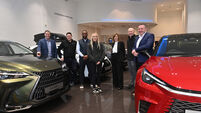The fall of birth rates, the rise of robots in a changing world

The main factors that impact on the birth rate are the number of women of childbearing age (15-49 years) and their fertility levels.
With the total fertility rate falling steadily from a high of 4.03 in 1965 to 1.8 births per woman in 2023- the impact on future economic growth of an increasingly ageing population is causing alarm - not just in Ireland, but across high income states globally.
At the same time, scant attention is being given to the reality that technological change is rapidly transforming work - with the potential to sever the historic link between the need for taxpaying workers to foster economic growth.
New and innovative technology can be a force for good, or it can be extremely destructive. Our focus should be on ensuring that sweeping changes to the workforce benefit ordinary citizens and not just the 1% who own the technology.
Added to that is the reality that continued exponential population growth on a planet with finite resources is unsustainable and potentially catastrophic.
Plummeting fertility rates in most countries over the next 25 years will leave growth concentrated in a minority of low-income states in sub-Saharan Africa and Asia that will have far-reaching social and economic impacts, the research warns.
The UN forecasts the global population could grow from 8 billion now to 9.7 billion in 2050, peaking at nearly 10.4 in the mid-2080s. Ireland’s total fertility rate is predicted to continue falling to 1.54 by 2050 and 1.4 by 2100.
Researchers point out there is no ‘silver bullet’ to mitigate the trends, although social policies like enhanced parental leave and free childcare could provide a ‘small boost’ to fertility rates.
The study focuses on the societal and economic headaches falling fertility rates will cause in developed countries; in terms of how economies will fund pensions and survive the loss of taxation resulting from so many workers leaving the workforce at the same time.
The dependency ratio - the number of adults and children in the economy depending on tax revenue from a diminishing pool of workers - is seen as the key problem.
The reality is that, at a time of heightened migration in recent years aggravated by war, climate change and poverty, migration is viewed in most developed nations as an unsustainable hindrance to economic prosperity.
In It’s Okay To Be Angry About Capitalism, Bernie Sanders suggests artificial intelligence could provide the answer. But if we want technological change to benefit everyone rather than widening inequality, than we need to start preparing now.
“The robots are coming, artificial intelligence is expanding, yet no-one is doing enough to ensure workers benefit rather than losing out,” wrote Sanders. “We have the power to shape a future that puts the benefits of social, political, and technological progress to work for the working class. The challenge is to seize that power.”
Sanders states that the pace and direction of technological change cannot be left to the market.
“If workers are going to be replaced by robots, as will be the case in many industries, we’re going to need to adapt tax and regulatory policies to assure that the change does not simply become an excuse for the race-to-the-bottom profiteering by multi-national corporations.”
Microsoft’s Bill Gates agrees, suggesting if a robot replaces a human worker who does $50,000 worth of work in a factory, the robot should be taxed at the same level as the worker.
Gates told Sanders the ‘robot tax’ revenues could be used to pay for the retraining of people whose jobs are eliminated or downsized due to automation. He suggests the retraining could focus on jobs “where human empathy and understanding are still very unique”, such as care of the elderly, having smaller class sizes, or helping kids with special needs.
A variation on the idea has been proposed in South Korea, one of the most rapidly automating countries in the world. In 2022, the government developed a tax reform plan that reduces tax credits for investment in automation technology.
What is clear is that the arrival of AI will transform the dependency of ongoing economic growth on high numbers of people in the 15-65 year old age group to support the needs of increasing numbers of elderly within the global population.
Once that question is resolved, the real dilemma is whether there are already too many humans on the planet, and whether falling fertility rates in developed countries globally, is a singular opportunity for the planet to realign itself within planetary boundaries and address wealth inequality.
The biosphere supports the planet by providing food, water, oxygen, waste removal, a stable and temperate climate and protection from harmful solar radiation. These systems do not exist in isolation but are powerfully interconnected. You can’t grow food without water and the distribution of water across the globe is dependent on a stable climate.
In Being The Change, climate scientist Peter Kalmus asks if 8 billion humans (living and eating as we’re actually living and eating today) is beyond carrying capacity, what is the sustainable limit?
Some evidence suggests the carrying capacity is about 4 billion. This estimate is based on the average area of land required to support one globally average person, including ecosystem services.
If everyone on the planet was vegetarian, Kalmus suggests we could likely double the number of humans that could sustainably live on it. Because about a third of food is wasted, limiting this waste could potentially increase carrying capacity by another quarter - about one or two billion people. depending on whether we are meat or vegetarian eaters - by eliminating half of this waste.
The real question about global fertility is not the threat to economies and society from a falling birth rate, but the absolute imperative for the fertility rate to fall exponentially - particularly in countries with the highest carbon footprints - if we are to have the remotest chance of preventing a global economy grounded in exponential growth from eating the planet alive.
Rather than focusing on ways to maintain fertility rates to sustain economies, we need to look beyond consumerism to search for ways that populations can live on Earth in alignment with the fantastically complex biosphere we were born into.
Dr Catherine Conlon is a public health doctor in Cork and former director of human health and nutrition, safefood







 App?
App?







